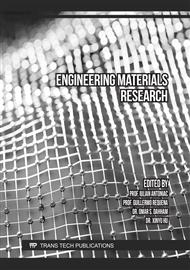[1]
Polajnar M, Kalin M, Thorbjornsson I, et al. Friction and wear performance of functionally graded ductile iron for brake pads, J. Wear. 382 (2017) 85-94.
DOI: 10.1016/j.wear.2017.04.015
Google Scholar
[2]
Patil S, Chilakamarri S, Markert B. A novel nonlinear nano-scale wear law for metallic brake pads, J. Physical Chemistry Chemical Physics. 20 (2018) 27-36.
DOI: 10.1039/c8cp01061g
Google Scholar
[3]
Kumar S, Kumar D, Jain J. A study on mechanical and tribological behavior of brake pad materials, J. Key Engineering Materials. 737 (2017) 162-167.
DOI: 10.4028/www.scientific.net/kem.737.162
Google Scholar
[4]
Agbeleye A, Esezobor D, Balogun S, et al. Tribological properties of aluminum-clay composites for brake disc rotor applications, J. Journal of King Saud University-Science. 32 (2017) 21-28.
DOI: 10.1016/j.jksus.2017.09.002
Google Scholar
[5]
Binder M, Klocke F, Doebbeler B. An advanced numerical approach on tool wear simulation for tool and process design in metal cutting, J. Simulation Modelling Practice and Theory. 70 (2017) 65-82.
DOI: 10.1016/j.simpat.2016.09.001
Google Scholar
[6]
Sellami A, Kchaou M, Elleuch R, et al. Thermal analysis of pad-on-disc contact under tribological solicitations: a coupled numerical–experimental approach to identify surface temperatures and flow partition coefficient, J. Heat & Mass Transfer. 52 (2016) 1923-1934.
DOI: 10.1007/s00231-015-1708-y
Google Scholar
[7]
Woldman M, Emile V, Tinga T, et al. A finite element approach to modelling abrasive wear modes, J. Tribology Transactions. 60 (2016) 711-718.
DOI: 10.1080/10402004.2016.1206647
Google Scholar
[8]
Gao W, Lian Y, Xie G, et al. Study of dry sliding wear characteristics of stellite 6B versus AISI M2 steel at various sliding velocities, J. Wear. 402-403 (2018) 169-178.
DOI: 10.1016/j.wear.2018.02.015
Google Scholar
[9]
Archard J F. Contact and rubbing of flat surfaces, J. Journal of Applied Physics. 24 (1953) 981-988.
DOI: 10.1063/1.1721448
Google Scholar
[10]
Joshua, K.J, Vijay S.J., Ramkumar P., et al. Effect of ZnO particles on microstructure, microhardness and wear behaviour of AA7068 metal matrix composites synthesized by powder metallurgy, J. Materials Science Forum. 979 (2020) 68-73.
DOI: 10.4028/www.scientific.net/msf.979.68
Google Scholar
[11]
Lee N & Kang C. The effect of a variable disc pad friction coefficient for the mechanical brake system of a railway vehicle, J. Plos One. 10 (2015) e0135459.
DOI: 10.1371/journal.pone.0135459
Google Scholar


